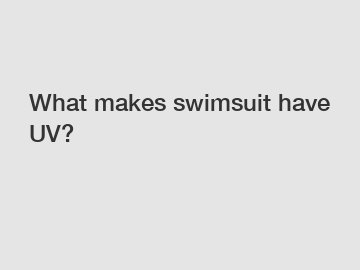What makes swimsuit have UV?
What makes swimsuits have UV?
Swimsuits are a must-have for anyone planning to spend time in the water during the hot summer months. But did you know that some swimsuits offer additional protection against harmful UV rays? This article will explore what makes swimsuits have UV protection and why it is essential for your overall skin health.
1. Material: One of the primary factors that determine whether a swimsuit has UV protection is the material it is made of. Many manufacturers now use specially treated fabrics that can block a certain percentage of UV rays. These fabrics often have a UPF (Ultraviolet Protection Factor) rating, similar to the SPF rating found in sunscreens. Swimsuits with a higher UPF rating offer greater UV protection.

2. Synthetic Fibers: Swimsuits made from synthetic fibers, such as nylon, polyester, and spandex, tend to provide better UV protection compared to natural fibers like cotton. Synthetic materials have a tighter weave, which makes it harder for UV rays to penetrate through. Additionally, some manufacturers add chemicals to the fabric during production to enhance its UV-blocking properties.
3. Weave Density: The tightness of the fabric weave also plays a crucial role in determining the level of UV protection a swimsuit offers. A tightly woven swimsuit with a high thread count will provide better defense against the harmful rays of the sun. In contrast, loosely woven fabrics or those with a lower thread count may let some UV rays penetrate through.
4. Color: Believe it or not, the color of your swimsuit can impact its UV protection ability. Darker colors tend to absorb more UV radiation, while lighter colors reflect it. Therefore, swimsuits in darker shades like black, navy, or deep red are more likely to offer better UV protection compared to pastel or lighter-colored swimsuits.
5. Treatment: Some swimsuit manufacturers go the extra mile to enhance their products' UV protection capabilities. They treat their fabrics with special chemicals or dyes that have UV-blocking properties. These treatments work by absorbing or scattering the UV rays and reducing their ability to harm your skin.
6. Overall Sun Safety: While swimsuits with UV protection are indeed beneficial, it is crucial to remember that they are only one part of the equation in protecting yourself from the sun. Wearing a UV-protective swimsuit should be complemented with other sun-safe practices such as applying sunscreen, wearing a wide-brimmed hat, and seeking shade during peak sun hours.
7. Benefits: Investing in a swimsuit with UV protection offers several benefits. Firstly, it reduces the risk of sunburn, premature aging, and skin damage caused by prolonged sun exposure. Secondly, it provides you with added peace of mind, ensuring that you can enjoy your time in the water without worrying about harmful UV rays. Lastly, UV-protective swimsuits are an excellent option for individuals with photosensitive skin conditions or those who have a higher risk of skin cancer.
In conclusion, swimsuits can have UV protection due to various factors, such as the material, weave density, color, and treatments applied during manufacturing. These features work together to offer protection against harmful UV rays, reducing the risk of sunburn and long-term skin damage. However, it is important to remember that wearing a UV-protective swimsuit should be part of a broader sun-safe routine, including applying sunscreen, seeking shade, and wearing protective accessories. By prioritizing sun safety, you can have peace of mind while enjoying your time in the water.
If you want to learn more, please visit our website whats a soft shell jacket, wholesale fleece jacket, jackets bulk.

Comments
0